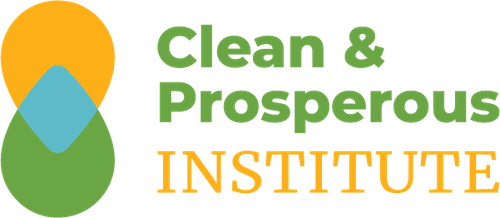We saw the future inside Tesla’s CA factory
Lesson # 4: Incentives are electric
Clean & Prosperous Institute led our second study mission to California last month. We learned so much from briefings and site tours, we want to continue sharing highlights with you here. (If you missed Lesson #1, about dairy digesters, click HERE. If you missed Lesson #2, about reducing emissions in overburdened communities, click HERE. If you missed Lesson #3, about how public investments from carbon revenues are catalyzing private sector innovation and investment, click HERE.)
What we learned
EV incentives are essential if we are going to reach greenhouse gas (GHG) emission goals. That includes California, Washington state and beyond.
Jonathan Changus is the Director of California Transportation Programs with the Center for Sustainable Energy. He gave our delegation a snapshot look at how Washington state is doing in the quest to meet our vehicle electrification goals. In 2021, 7.8% of Washington’s new passenger vehicle sales were EVs. But, our state needs to be at 31% by the end of 2023 to be on track to meet our 2030 goal.

So what do we do? What is California doing? INCENTIVIZE, INCENTIVIZE, INCENTIVIZE.
Changus told us that incentives work well to accelerate the zero-emission vehicles (ZEVs) market.
China has spent over $200 billion on EV incentives since 2009, and in 2021 EVs accounted for 16% of new car sales. In Norway, where incentives have been in place since 1990, EV sales reached 84% in March 2022. In California where incentives were introduced in 2010, EVs were 16.3% of new light-duty vehicles by Q1 2022. Clearly, incentives can help consumers overcome barriers to adopting new technology.
Meanwhile, Washington’s passenger EV sales tax exemption is winding down, just as the transition to vehicle electrification is ramping up. Fortunately for us, last session the Legislature indicated interest in designing new electric vehicle purchase incentives by putting aside $120 million for the task, with $25 million specifically directed to overburdened communities.

One of California’s most effective incentive programs is Clean Cars 4 All, which helps lower-income residents replace old, polluting cars with cleaner, more fuel efficient vehicles. The program’s guiding legislation directs benefits to low-income and disadvantaged communities and has a heavy emphasis on consumer protections and education.
EVs can be big and yellow, too
 We heard from the Twin Rivers Unified School District near Sacramento. Of the 60 school buses used to transport 5,000 students each day, 49 are electric. How did they do this? They gathered incentive funding for both buses and infrastructure. Notice the blue hubcaps and bumper on the electric bus? The School District’s Ray Manalo said it was a visible way of getting kids and parents excited about the transition to clean energy buses.
We heard from the Twin Rivers Unified School District near Sacramento. Of the 60 school buses used to transport 5,000 students each day, 49 are electric. How did they do this? They gathered incentive funding for both buses and infrastructure. Notice the blue hubcaps and bumper on the electric bus? The School District’s Ray Manalo said it was a visible way of getting kids and parents excited about the transition to clean energy buses.
The future is now
Californians aren’t just buying EVs, they’re amping up their economy by building them. Our group got a VIP, “no photos allowed” tour of Tesla’s enormous production factory, a building large enough to hold 92 football fields!

We were ushered into the waiting area, taken through a maze of halls and led into an almost “Disneyland-like” loading zone, where we boarded little red trams for a ride through the largest auto production factory in North America.
We watched in awe as hundreds of huge robots (named after some of Elon Musk’s favorite movie characters) moved the largest Tesla components along the assembly line. Just a week prior to our visit, the factory set a new single-day production record, estimated to be about one car per minute!
As we wheeled past more giant robots with names like Wolverine and Iceman, we learned that Tesla had added a second floor to house even more robots in order to accommodate larger production numbers.
We didn’t want this glimpse into modern factory production to end as we continued around corner after corner, narrowly sliding past robotic wagons carrying different auto parts to their appointed stations. It looked like a city, as Tesla had added many features to brighten what was once a dark, enclosed space and we could see employees enjoying their breaks under the added skylights, the neatly painted floors with white epoxy and lots of natural plants to create gathering spaces.

Aristotle’s quote, “Quality is not an act, it is a habit,” adorned one of the walls we drove past, as we prepared to end this fascinating, hour-long tour.
But perhaps the group’s favorite quote and one we will all remember, read: “When something is important enough, you will do it, despite the odds.” And that brings us back to the work we have in front of us, building Washington’s clean energy economy. We aim to apply the lessons we learned in California to drive investments and smart policy decisions here at home.
Coming soon, more lessons learned in California, including their blue and green hydrogen economy, the future of batteries (courtesy of Sila Nanotechnologies) and more. A full trip report is being prepared chronicling the entire trip and the myriad of lessons learned.

